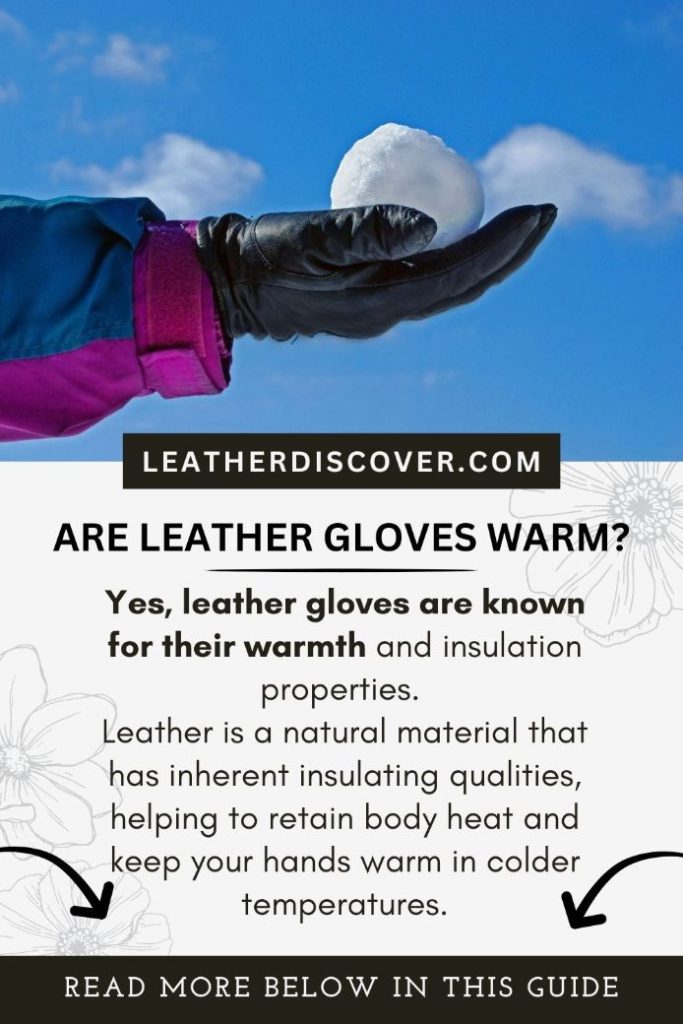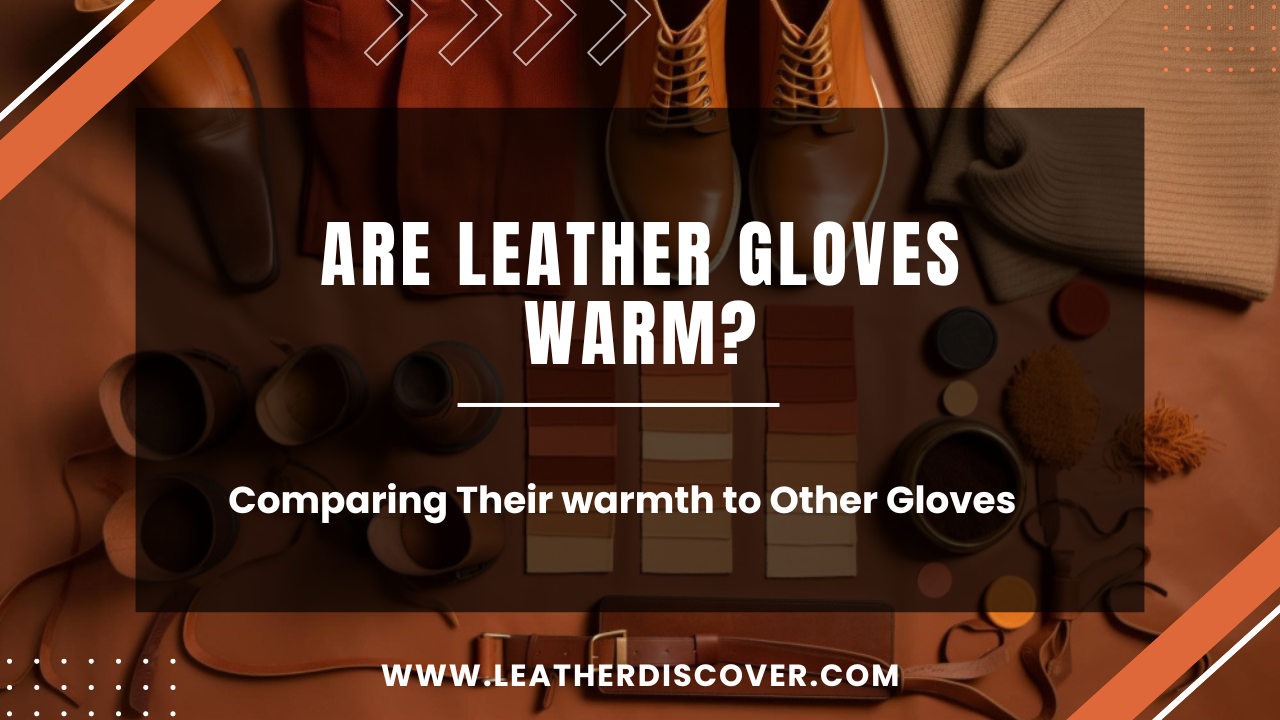The question of whether leather gloves are warm is a common inquiry, especially as we seek to strike a balance between style and functionality in our winter wardrobe.
Leather, renowned for its durability and timeless appeal, has been a staple in the world of gloves for generations. Yet, when it comes to the bitter chill of winter, the warmth of leather can be a subject of curiosity.
In this article, we will explore: Are leather gloves warm? Which leather gloves are the warmest? Comparing leather gloves’ warmth with other gloves, and more!
[toc]

Are Leather Gloves Warm?
Yes, leather gloves are known for their warmth and insulation properties.
Leather is a natural material that has inherent insulating qualities, helping to retain body heat and keep your hands warm in colder temperatures. The thickness and type of leather used in the gloves can impact their warmth.
Thicker and more insulated leather gloves, like those lined with materials such as fleece or wool, tend to provide better protection against cold weather.
However, it’s important to note that while leather gloves offer decent warmth, they might not be as effective in extremely cold conditions compared to specialized winter gloves made with advanced synthetic materials designed specifically for extreme cold weather.
Additionally, the fit of the gloves also plays a role in their warmth retention. Gloves that fit snugly prevent cold air from entering and warm air from escaping, enhancing their overall warmth.
Comparing Leather Gloves’ Warmth With Other Gloves:
Here’s a comparison table that evaluates the warmth of leather gloves compared to other types of gloves:
| Glove Type | Warmth Level | Pros | Cons |
|---|---|---|---|
| Leather Gloves | Moderate to High | – Natural insulation – Stylish and durable – Good for cold, dry conditions | – Less effective when wet – Can be less flexible than some alternatives – May require maintenance |
| Wool Gloves | High | – Excellent insulation even when wet – Soft and comfortable – Good for cold, damp conditions | – Not as durable as leather – May itch for some wearers |
| Fleece Gloves | Moderate | – Lightweight and breathable – Good for cool, not extremely cold, conditions | – Not suitable for very cold weather – Limited water resistance |
| Down Gloves | Very High | – Exceptional insulation – Lightweight and packable – Ideal for extremely cold conditions | – Expensive – Lose insulation when wet – May lack durability |
| Thinsulate Gloves | High | – Excellent insulation without bulk – Retains warmth when damp – Good for a variety of conditions | – Can be pricey – Quality varies by brand – Less stylish than leather or wool |
| Synthetic Gloves | Moderate | – Affordable – Water-resistant – Good for cool to moderately cold conditions | – Less insulation than down or wool – May not be as durable as leather or Thinsulate |
Keep in mind that individual preferences and specific use cases can also impact how warm a particular glove type feels to a person.
Which Leather Gloves Are the Warmest?
Here are some types of leather gloves that can help you decide which leather gloves are the warmest for you:
1. Shearling-Lined Leather Gloves:
Shearling is a soft, natural sheepskin with the wool still attached. These gloves are incredibly warm and provide excellent insulation due to the insulating properties of shearling.
2. Deerskin Gloves:
Deerskin leather is known for its softness and warmth. Deerskin gloves are often lined with materials like Thinsulate or fleece for added insulation.
3. Elkskin Gloves:
Elkskin is a thick and durable leather that offers good insulation. Elkskin gloves are ideal for colder weather, especially when lined with a warm material.
4. Lambskin Gloves:
Lambskin is soft and supple, making it comfortable to wear. When paired with a warm lining like cashmere or fleece, lambskin gloves can provide adequate warmth for moderate cold.
5. Horsehide Gloves:
Horsehide leather is known for its durability and thickness. While not as soft as some other leathers, it offers good protection against the cold when lined with warm materials.
6. Gloves with Thinsulate Lining:
Thinsulate is a synthetic insulation material often used in gloves. Leather gloves with Thinsulate lining can provide excellent warmth without adding excessive bulk.
7. Heated Leather Gloves:
Some leather gloves come with built-in heating elements, offering customizable warmth levels for extreme cold conditions.
Keep in mind that the warmth of leather gloves can also be influenced by their fit. A snug fit helps retain heat by preventing cold air from entering and warm air from escaping.
Are Leather Gloves Bad for Winter?
Leather gloves are not inherently bad for winter; however, their suitability for winter largely depends on the specific type of leather, the glove’s design, and the intended use.
Here are some considerations regarding leather gloves in winter:
1. Type of Leather:
Some types of leather, like deerskin, shearling, and lambskin, are naturally warmer and more suitable for winter than others.
These leathers offer good insulation and can keep your hands warm in moderately cold conditions.
2. Lining Material:
Many leather gloves designed for winter use are lined with warm materials like fleece, Thinsulate, or shearling. These linings enhance the glove’s insulation and make them suitable for colder temperatures.
3. Design:
The design of leather gloves can vary widely. Look for gloves with features that help seal out cold air, such as wrist closures or gauntlets that extend over the wrists. A snug fit is also important for retaining heat.
4. Water Resistance:
The leather itself is not inherently waterproof, and wet leather can be less insulating and comfortable in cold weather.
If you expect wet or snowy conditions, consider leather gloves that have been treated for water resistance or combine them with a waterproof overmitt.
5. Activity Level:
Leather gloves can be suitable for less physically demanding winter activities like casual wear, driving, or urban commuting. However, for more active pursuits like skiing or snowboarding, specialized winter sports gloves may be a better choice due to their specific insulation and features.
What Is the Best Way to Choose Warm Gloves?
The best way to choose warm gloves involves several key considerations.
- First, prioritize insulation; look for gloves with effective insulating materials like Thinsulate or down, as thicker insulation typically provides better warmth.
- Second, pay attention to the lining; materials like fleece or shearling enhance warmth and comfort.
- Third, ensure a snug fit that covers your wrists to prevent cold air from entering. Consider the specific activities you’ll be engaged in, as different gloves are designed for various purposes, from skiing to casual wear.
- Lastly, factor in water resistance if you anticipate wet conditions. By considering these aspects, you can select gloves that provide the necessary warmth and protection for your needs and weather conditions.
Can I Wear Leather Gloves in Summer?
Wearing leather gloves in summer is generally not recommended. Leather is not a breathable material like lightweight fabrics, and it can trap heat, causing your hands to feel hot and sweaty in warm weather.
For summer, it’s better to choose gloves made from breathable materials like cotton, linen, or synthetic blends that provide ventilation and keep your hands cool.
Is It OK to Get Leather Gloves Wet?
While leather gloves can handle some moisture, it’s best to avoid getting them soaking wet.
Excessive moisture can damage the leather, causing it to lose its shape, become stiff, or even develop mold. If your leather gloves get wet, allow them to air dry naturally at room temperature, away from direct heat sources, and avoid using artificial heat like hair dryers or radiators, which can further damage the leather.
After drying, you may need to apply a leather conditioner to maintain the glove’s softness and suppleness.
Conclusion:
So, now you know the answer to the question “Are leather gloves warm?” “Which leather gloves are the warmest” and more!
Leather gloves can indeed provide warmth, thanks to their natural insulating properties and the potential for added warmth through various lining materials.
Ultimately, the warmth of leather gloves can meet the needs of many, making them a stylish and practical choice for cold weather.
- What Is Caiman Leather? A Detailed Guide - July 25, 2024
- What Is Tumbled Leather?A Complete Guide - July 25, 2024
- What Is Kip Leather? Premium Leather Choice - July 24, 2024

